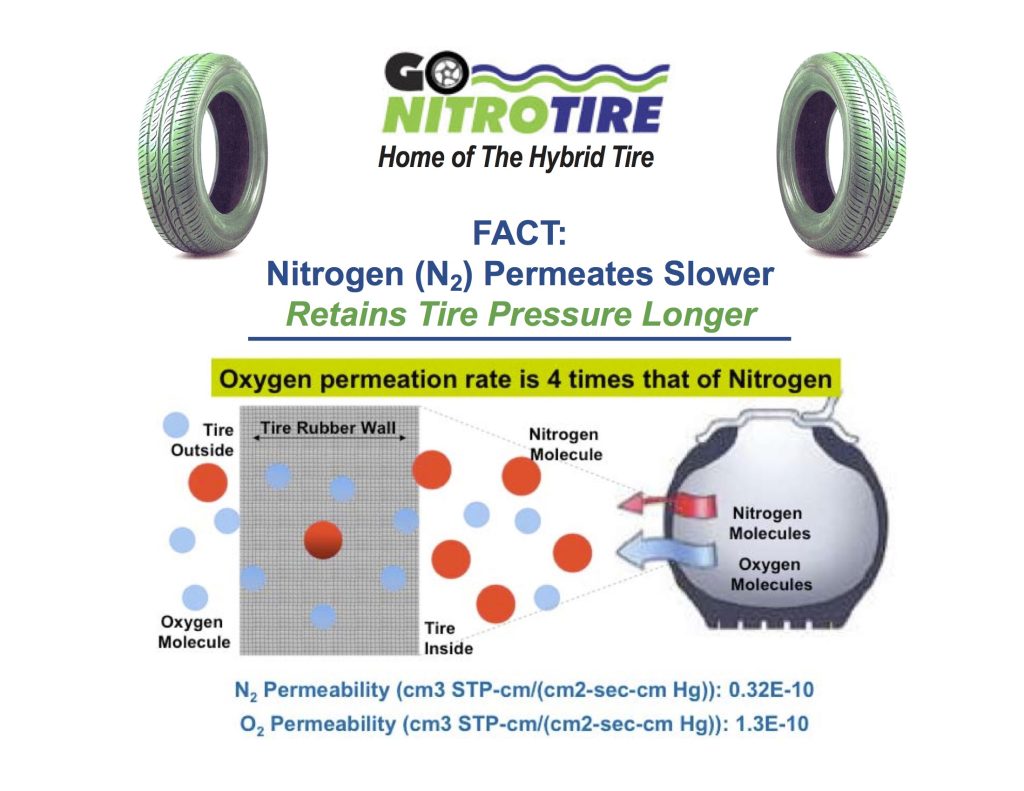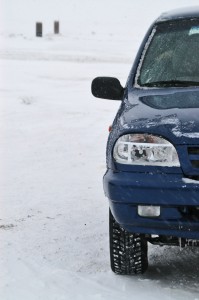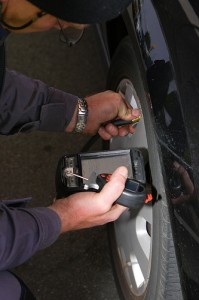
Fact: Nitrogen permeates slower and so retains tire pressure longer than oxygen.
 Nitronomics
Nitronomics Winter is in full swing! Over 20% of the U.S population was affected by last week’s storm, making driving difficult for many people (and driving still might be difficult in some places). One of the last things people are thinking about in these road conditions is the condition of their tires, but tires with right pressure are what you need to navigate winter roads. The best way to ensure that your tires have proper tire pressure is with nitrogen tire inflation. Here are the winter benefits of putting nitrogen in your tires:
Winter is in full swing! Over 20% of the U.S population was affected by last week’s storm, making driving difficult for many people (and driving still might be difficult in some places). One of the last things people are thinking about in these road conditions is the condition of their tires, but tires with right pressure are what you need to navigate winter roads. The best way to ensure that your tires have proper tire pressure is with nitrogen tire inflation. Here are the winter benefits of putting nitrogen in your tires:
When driving on icy and slippery winter roads, you need tires that can handle those conditions. This means that tires that are underpressure, or have uneven wear, are going to give you as much trouble as the road conditions themselves. Proper tire pressure solves the first, and it solves the second since its typically a tire that’s below pressure that will wear unevenly. To solve for proper tire pressure, nitrogen tire inflation does the trick. Nitrogen tires maintain proper tire pressure for longer periods of time, which is one comforting thing to have when traveling through severe weather.
With winter road conditions, commute times are longer because you have to be more careful on the roads. You might also have to take different routes to avoid accidents and traffic. All that means you’re burning more fuel and increasing how much you spend on gas. To keep that to a minimum, (besides avoiding the roads all together) you can fill your tires with nitrogen. Because of the proper tire pressure benefit, nitrogen tire inflation increases your fuel efficiency by three percent, which can make a big difference as gas prices and the amount of gas we’re using goes up. Of course, one of the last things you want to happen when driving in this weather is to run of gas and to be stranded. Get the most out of every drop of fuel with nitrogen tire inflation.
Air-filled tires are much more sensitive to temperature changes than nitrogen tires, so with air-filled tires you run the risk of driving on tires that are below pressure. It also means that while you’re driving, your tire pressure will also fluctuate with larger swings. These sorts of changes do not represent the safety that you want when you are driving on icy roads, or at the beginning of snow fall when the road surface changes. Since nitrogen tires better withstand the extreme temperatures of winter, they are much safer for driving than air-filled tires.
Driving when the roads aren’t safe may seem like a gamble, but you can increase your chances of arriving safely with tires that are ready for these conditions. Even with snow tires, you want your wheels to be reliable and to be able to withstand the unpredictability of winter roads. Winter may already be halfway over, but the driving never is, and nitrogen tire inflation is still beneficial once the snow stops. So, it’s not too late to fill your tires with nitrogen, and you don’t have to wait until next winter to do it.
Related Links:
The Advantages and Disadvantages of Nitrogen Tire Inflation
 We’ve done out best to bust nitrogen tire inflation myths and other arguments against the practice. Some of these arguments are understandable and logical, but others are just plain wacky. These wacky arguments skew the discussion because some people may believe them, leading them to thinking nitrogen tire inflation is a scam because nitrogen tire dealers and providers are making wild claims about the practice. Not only are dealers and providers not making these claims (we can’t speak for the mechanic or the salesperson, but we assure that those who sell the equipment aren’t making these claims), but these claims are just wrong. Here are a few them that we found and would like to bust right now:
We’ve done out best to bust nitrogen tire inflation myths and other arguments against the practice. Some of these arguments are understandable and logical, but others are just plain wacky. These wacky arguments skew the discussion because some people may believe them, leading them to thinking nitrogen tire inflation is a scam because nitrogen tire dealers and providers are making wild claims about the practice. Not only are dealers and providers not making these claims (we can’t speak for the mechanic or the salesperson, but we assure that those who sell the equipment aren’t making these claims), but these claims are just wrong. Here are a few them that we found and would like to bust right now:
As for moisture, changes in humidity affect tire performance two ways. First, the density of humid air fluctuates more with temperature than that of dry air, so removing humidity can keep your tire pressure more consistent, especially when the temperature climbs over 100 degrees Fahrenheit. That may be a legitimate concern in Formula One racing, but it’s not much of an issue if you’re just tooling around town. – The Straight Dope
The density of humid air has nothing to do with tire performance. Humid air is bad for your tires because it is humid, because the water vapor is very susceptible to temperature changes and causes the tire pressure to fluctuate. This also happens at temperatures below 100 degrees Fahrenheit because as you drive, you heat up the tires, no matter what the temperature is on the outside. They’re moving, there’s friction, and all that creates heat. All this is a concern if you’re just tooling around town, because tooling around town creates heat as well, and the water vapor in your tires is still reacting.
Another claim I’ve seen is that since nitrogen is slightly lighter than air, you’ll save weight and get better performance. However, we’re talking about a weight difference of less than 4 percent of the gas in the tire – in other words, a difference of less than an ounce for most vehicles. – Also The Straight Dope
We have no idea who said this, but the better performance from nitrogen doesn’t come from saving weight. It comes from the fact that nitrogen maintains proper tire pressure for a longer period of time, and its the proper tire pressure that creates better performance and handling.
The argument for using Nitrogen in your car tires is this: Air and Nitrogen would compress at different rates depending on temperature, with air being more squishy than Nitrogen, and that would cause your tires’ pressure to vary more with air than with Nitrogen. – Scienceblogs.com
More squishy? What does that even mean? Just because this argument is coming from a science blog doesn’t meant that it’s scientifically sound.
Proper inflation is the real issue. Under-inflated tires reduce gas mileage. They flatten out, creating more surface area and thus adding friction, which makes the engine work harder. The extra friction, and resulting heat, also increases the chance of a blowout. A properly inflated tire is always safer and more efficient than under-inflated shoes (unless you’re driving across a sand dune). – The Truth about Cars
If only it were this simple. Since air-filled tires are much more susceptible to temperature changes, there are chances for an inaccurate reading when checking the tire pressure of an air-filled tire. For example, if a consumer stops at a gas station after spending some time running errands and driving around, and decides to check their tire pressure, it’s likely that they’ll get a reading that is higher than what the tire pressure really is. The reason is the tires have been heated up from the previous driving,
This could mean that the consumer gets a reading that says their tire pressure is fine, or is too high, and will do nothing about a tire that’s really low or will make it low by releasing pressure to compensate for the high reading. This is why it’s recommended to check tire pressure when the tires a cool, such as before starting the car or after being parked for a few hours. Since tire pressure ought to be checked when the tires are cool, this means that tires would need to be refilled at home with an at-home air compressor (since most people would have to drive to the gas station to get to their air compressor, heating up the tires and ruining the reading).
Sure, fall just got here, but let’s not wait until the snow falls before we start to prepare our tires for the winter months. Especially if you live in a part of the country where the switch from summer to winter can be quick, there’s not a whole lot of time before winter is upon is. Here are a few things to do to prepare your tires for the upcoming cold and harsh weather:
Industry suggests getting new tires once they are between six and 10 years of age. The reason why is that air migrates through the tire, making it brittle and reducing its strength. The only way to prevent the air from migrating and reducing the strength of your tire is to remove the air from you tire all together. Then, replace it with pure nitrogen with nitrogen tire inflation. That way, you extend the life of your tire, giving it more of those golden years on the road instead of in the dump.
Just like how you can find the maximum tire pressure allowed for your tire, you can figure out how old your tire is looking on the outside. If the tire was made after the year 2000, it has four digits. The first two indicate the week, the last two the year. If the tire has only three digits, it was made prior to 2000, with the first two indicating the week, and the last digit indicating the year of the decade. Tires that are older than 10 years old are considered unsafe for driving. Perhaps it’s because by then, they’ve become brittle and have suffered from the old tire disease of oxidation. Give your tires the fountain of youth with nitrogen tire inflation.
Nitrogen tire inflation has been proven to extend the life of your tires. Many tires companies, including Michelin and Goodyear, support the practice of nitrogen tire inflation. It’s a practice that’s already being used by the airline industry and NASCAR. It’s about time that it’s used in the consumer market as well.

